Mystery Fossil Archives#1–9 | #10–18 | #19–27 | #28–36 | #37–45 | #46–54
Click on the image for a closer look at each Mystery Fossil. Can you guess
them all correctly? |
|
#19—March, 2002 |
|
 |
The fossil record for this kind of organism is scanty because these organisms tend to dominate habitats where the conditions for fossilization are poor. Though the oldest known fossil of this type of organism dates from the early Devonian, this particular specimen is from the Miocene of California. Do you know what it is?
|
#20—April, 2002 |
|
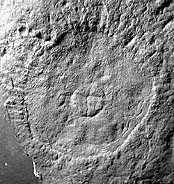 |
This may look like an aerial photo of a moon crater but it is actually the earliest known fossil of a particular group of primarily marine organisms still living today. Simple forms of this group of organisms had a worldwide distribution as early as the Cambrian Period. Do you know what it is?
|
#21—May, 2002 |
|
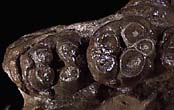 |
This is a top view of two teeth in the jaw of an unusual animal, a member of a now extinct group of marine mammals (Late Oligocene–Miocene). The teeth and their pattern of wear are unlike that seen in any modern mammal so what this animal ate is something of a mystery. This is not much to go on but do you know what this animal is?
|
#22—June/July, 2002 |
|
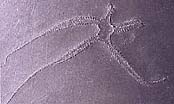 |
A starfish, right? Not exactly. Modern descendants of these marine organisms can be found in tide pools or as deep as four miles. Their fossils are rare and the particular group represented by this fossil went extinct in the Mississippian Period. Do you know what it is?
|
#23—August/September, 2002 |
|
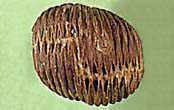 |
Is it a walnut? A Halloween pumpkin? Afraid not. Only about 250 species of this type of critter still exist today but they were very abundant in Paleozoic and Mesozoic oceans—over 3,000 fossil species are known! Now do you know what it is?
|
#24—October, 2002 |
|
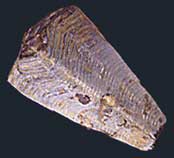 |
This organism is a true mystery fossil. Though fossils of these marine invertebrates are not rare, scientists are unsure of how to classify
them. They lived from the Lower Cambrian to the Triassic. Can you guess what this organism is?
|
#25—November, 2002 |
|
 |
Click the image for a better look. Forests of these trees were common in the Tertiary Period. They were thought to be long
extinct until a living species was discovered in China in 1941. Do you know what it is?
|
#26—December, 2002 |
|
 |
This successful genus originated in North America in the early Miocene, crossed into and spread across Asia, Europe, and finally Africa, where it survived into the Plesitocene.
This may not be enough for you to name the specific genus but do you know what it is?
|
#27—January, 2003 |
|
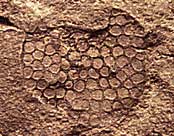 |
This is a tough one. Click on the image to get an idea of the size of this organism. The best clue we can give you is that these organisms
are considered to be the closest living relatives of land plants. Knowing that, can you name this group of organisms?
|
|
#1–9 | #10–18 | #19–27 | #28–36 | #37–45 | #46–54 Home | What's new | About UCMP | History of life | Collections | Other resources |
|
| |
|